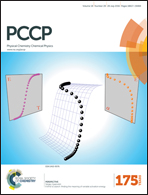Electronic structures of CuTPP and CuTPP(F) complexes. A combined experimental and theoretical study I†
Abstract
Copper complexes of tetraphenylporphyrin (H2TPP) and tetrakis(pentafluorophenyl)porphyrin (H2TPP(F)) deposited as thin films on Au(111) have been studied experimentally and theoretically. Core level emissions from C 1s, N 1s, F 1s and Cu 2p as well as valence states of CuTPP and CuTPP(F) have been investigated using surface photoelectron spectroscopy. The interpretation of experimental results has been guided by theoretical calculations carried out on isolated species in the habit of the density functional theory. Reference to experimental and theoretical outcomes pertaining to H2TPP and H2TPP(F) allowed a confident and detailed assignment of the title molecules' X-ray and ultraviolet photoemission data. With specific reference to the latter, similar to copper phthalocyanine (CuPc), whose coordinative pocket mirrors the CuTPP/CuTPP(F) ones, the lowest ionization energy of the title compounds implies electron ejection from a ring orbital rather than from the Cu 3d-based singly occupied molecular orbital. Moreover, analogous to CuPc, the ionic contribution appears to play an important role in the Cu–N bonding. Nevertheless, differences in the number, symmetry, nature and relative position of CuTPP/CuTPP(F) occupied frontier orbitals compared to CuPc may be stated only by considering in great detail the Cu-ligand covalent interactions.


 Please wait while we load your content...
Please wait while we load your content...